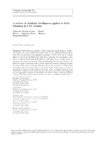Mostrar o rexistro simple do ítem
A review of artificial intelligence applied to path planning in UAV swarms
| dc.contributor.author | Puente-Castro, Alejandro | |
| dc.contributor.author | Rivero, Daniel | |
| dc.contributor.author | Pazos, A. | |
| dc.contributor.author | Fernández-Blanco, Enrique | |
| dc.date.accessioned | 2023-12-11T10:36:25Z | |
| dc.date.available | 2023-12-11T10:36:25Z | |
| dc.date.issued | 2021 | |
| dc.identifier.citation | A. Puente-Castro, D. Rivero, A. Pazos, and E. Fernández-Blanco, "A review of artificial intelligence applied to path planning in UAV swarms", Neural Computing and Applications, vol. 34, pp. 153–170, 2022. https://doi.org/10.1007/s00521-021-06569-4 | es_ES |
| dc.identifier.uri | http://hdl.handle.net/2183/34440 | |
| dc.description | This version of the article has been accepted for publication, after peer review and is subject to Springer Nature’s AM terms of use, but is not the Version of Record and does not reflect post-acceptance improvements, or any corrections. The Version of Record is available online at: https://doi.org/10.1007/ s00521-021-06569-4 | es_ES |
| dc.description | This is the accepted version of: A. Puente-Castro, D. Rivero, A. Pazos, and E. Fernández-Blanco, "A review of artificial intelligence applied to path planning in UAV swarms", Neural Computing and Applications, vol. 34, pp. 153–170, 2022. https://doi.org/10.1007/s00521-021-06569-4 | es_ES |
| dc.description.abstract | [Abstract]: Path Planning problems with Unmanned Aerial Vehicles (UAVs) are among the most studied knowledge areas in the related literature. However, few of them have been applied to groups of UAVs. The use of swarms allows to speed up the flight time and, thus, reducing the operational costs. When combined with Artificial Intelligence (AI) algorithms, a single system or operator can control all aircraft while optimal paths for each one can be computed. In order to introduce the current situation of these AI-based systems, a review of the most novel and relevant articles was carried out. This review was performed in two steps: first, a summary of the found articles; second, a quantitative analysis of the publications found based on different factors, such as the temporal evolution or the number of articles found based on different criteria. Therefore, this review provides not only a summary of the most recent work but it gives an overview of the trend in the use of AI algorithms in UAV swarms for Path Planning problems. The AI techniques of the articles found can be separated into four main groups based on their technique: reinforcement Learning techniques, Evolutive Computing techniques, Swarm Intelligence techniques, and, Graph Neural Networks. The final results show an increase in publications in recent years and that there is a change in the predominance of the most widely used techniques. | es_ES |
| dc.description.sponsorship | This work is supported by Instituto de Salud Carlos III, grant number PI17/01826 (Collaborative Project in Genomic Data Integration (CICLOGEN) funded by the Instituto de Salud Carlos III from the Spanish National plan for Scientific and Technical Research and Innovation 2013–2016 and the European Regional Development Funds (FEDER)—“A way to build Europe.”. This project was also supported by the General Directorate of Culture, Education and University Management of Xunta de Galicia ED431D 2017/16 and “Drug Discovery Galician Network” Ref. ED431G/01 and the “Galician Network for Colorectal Cancer Research” (Ref. ED431D 2017/23). This work was also funded by the grant for the consolidation and structuring of competitive research units (ED431C 2018/49) from the General Directorate of Culture, Education and University Management of Xunta de Galicia, and the CYTED network (PCI2018_093284) funded by the Spanish Ministry of Ministry of Innovation and Science. This project was also supported by the General Directorate of Culture, Education and University Management of Xunta de Galicia “PRACTICUM DIRECT” Ref. IN845D-2020/03. | es_ES |
| dc.description.sponsorship | Xunta de Galicia; ED431D 2017/16 | es_ES |
| dc.description.sponsorship | Xunta de Galicia; ED431G/01 | es_ES |
| dc.description.sponsorship | Xunta de Galicia; ED431D 2017/23 | es_ES |
| dc.description.sponsorship | Xunta de Galicia; ED431C 2018/49 | es_ES |
| dc.description.sponsorship | Xunta de Galicia; IN845D-2020/03 | es_ES |
| dc.language.iso | eng | es_ES |
| dc.publisher | Springer | es_ES |
| dc.relation | info:eu-repo/grantAgreement/AEI/Plan Estatal de Investigación Científica y Técnica y de Innovación 2017-2020/PCI2018-093284/ES/OBESIDAD Y DIABETES EN IBEROAMERICA: FACTORES DE RIESGO Y NUEVOS BIOMARCADORES PATOGENICOS Y PREDICTIVOS | es_ES |
| dc.relation | info:eu-repo/grantAgreement/ISCIII/Plan Estatal de Investigación Científica y Técnica y de Innovación 2013–2016/PI17%2F01826/ES/PROYECTO COLABORATIVO DE INTEGRACION DE DATOS GENOMICOS (CICLOGEN). TECNICAS DE DATA MINING Y DOCKING MOLECULAR PARA ANALISIS DE DATOS INTEGRATIVOS EN CANCER DE COLON/ | es_ES |
| dc.relation.isversionof | https://doi.org/10.1007/s00521-021-06569-4 | |
| dc.relation.uri | https://doi.org/10.1007/s00521-021-06569-4 | es_ES |
| dc.rights | Copyright © 2021, The Author(s), under exclusive licence to Springer-Verlag London Ltd., part of Springer Nature | es_ES |
| dc.subject | Unmanned aerial vehicle | es_ES |
| dc.subject | UAV | es_ES |
| dc.subject | Swarm intelligence | es_ES |
| dc.subject | Path planning | es_ES |
| dc.title | A review of artificial intelligence applied to path planning in UAV swarms | es_ES |
| dc.type | info:eu-repo/semantics/article | es_ES |
| dc.rights.access | info:eu-repo/semantics/openAccess | es_ES |
| dc.identifier.doi | 10.1007/s00521-021-06569-4 |
Ficheiros no ítem
Este ítem aparece na(s) seguinte(s) colección(s)
-
GI-RNASA - Artigos [195]






